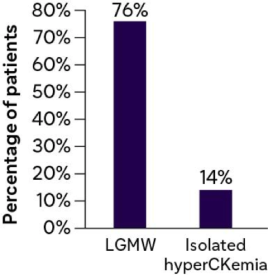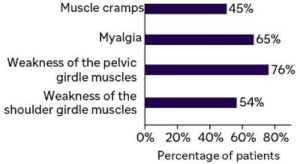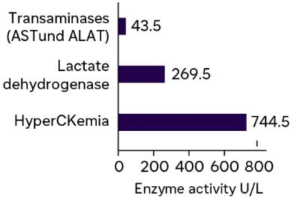- Article
- Source: Campus Sanofi
- May 20, 2025
Prevalence Of LOPD In Patients With Undifferentiated Proximal Myopathy And Undiagnosed Muscle Biopsy
_430x268.jpg)
Study objective and method
| Examine patients with LGMW and/or hyperCKemia and undiagnosed muscle biopsy for LOPD |
⬇ |
| Inclusion criteria: Inconclusive LGMW with undiagnosed muscle biopsies |
⬇ |
|
Of the 340 evaluated muscle biopsies, 69 fulfilled the inclusion criteria |
⬇ |
| Testing: DBS+enzyme activity of GAA |
Results
Baseline characteristics of patients with unclassified LGMW
%20(1).png)
.png)

Median age
51 years

Median symptom onset
6 years
Clinical and laboratory data of patients with unclassified LGMW
Median DBS GAA activity: 1.18 nmol/punch×21 hours
Reduced GAA activity was identified through enzyme kinetic testing in two patients
Myopathic symptoms
.png)
Laboratory results
.png)
Diagnostic yield of LOPD: 2/69 (2.9%) | |||
| Patient 1 | Patient 2 | ||
| A 22-year–old Caucasian female with the chief complaint of muscular exertion intolerance associated with muscle aches and cramps. |
| A 29-year–old Caucasian male with atrophies of the shoulder, pelvic girdle, and paravertebral muscles. Predominantly left-sided scapula alata and positive Gower’s sign. | |
| Completely unspecific myopathic changes with evidence of small lipid droplets |
|
| |
| No signs of HCM, FVC: <80% |
| No signs of HCM, FVC: 72% | |
LOPD not only demonstrates wide variability in the clinical phenotype but also in the histopathological changes in the skeletal muscles. | |||
Conclusion

Revisiting muscle biopsies is important in neuromuscular disease diagnosis.

Muscle biopsy can aid in LOPD identification, but glycogen-related vacuolation can be absent.

An inconclusive muscle biopsy does not rule out Pompe disease.

DBS evaluation should precede muscle biopsy for all LGMW patients
ALAT: Alanine aminotransferase; AST: Aspartate transaminase; CK: Creatine kinase; DBS: Dried blood spots; FVC: Forced vital capacity; HCM: Hypertrophic cardiomyopathy; LGMW: Limb-girdle myopathic weakness; LOPD: Late-onset Pompe disease.
-
Golsari A, Nasimzadah A, Thomalla G, et al. Prevalence of adult Pompe disease in patients with proximal myopathic syndrome and undiagnosed muscle biopsy. Neuromuscul Disord. 2018;28(3):257–261.
MAT-KW-2300241 V1 Jul 2023